Mastering Cloud Observability: Techniques, Tools, and Trends
Vishal Vaid
Mar 8, 2024
Introduction to Cloud Observability
At its essence, cloud observability is the methodology and practice of making cloud applications and environments fully transparent and understandable. It involves collecting, analyzing, and acting on metrics, logs and traces to gain comprehensive insights into the performance and health of cloud infrastructures and services.
Observability is critical in modern cloud environments, where systems are often complex and dynamic. It goes beyond traditional monitoring, providing deeper insights into the inner workings of cloud applications and infrastructure. This comprehensive visibility is crucial for ensuring system reliability, optimizing performance, and swiftly addressing issues. As businesses increasingly rely on cloud-based solutions, mastering cloud observability has become indispensable for maintaining operational excellence and delivering seamless digital experiences. This blog will explore the various facets of cloud observability, its tools, best practices, and emerging trends, offering a thorough guide for anyone navigating this essential cloud computing domain.
The Three Pillars of Cloud Observability
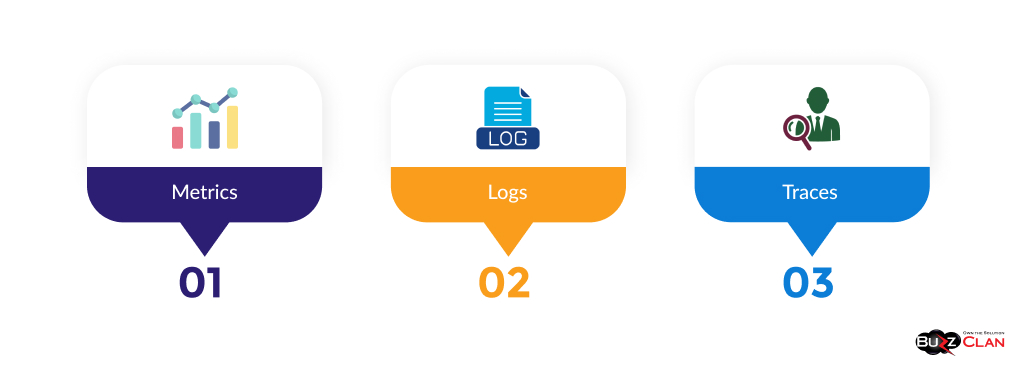
Cloud observability stands on three fundamental pillars: Metrics, Logs, and Traces. These pillars form the backbone of effective cloud management, allowing teams to monitor, understand, and optimize their cloud environments.
- Metrics: Metrics are quantitative measurements that provide insights into the performance of various aspects of the cloud environment. They include CPU usage, memory consumption, and response times. Metrics are crucial for understanding the system's health, identifying trends, and making data-driven decisions.
- Logs: Logs are detailed records of cloud infrastructure and application events. They provide the narrative context to the metrics, offering a granular view of what's happening at any given moment. Analyzing logs helps troubleshoot, understand the sequence of events leading to an issue, and ensure compliance with audit requirements.
- Traces: Traces track individual user requests as they move through the various components of a cloud-based application. They are essential for understanding the user experience and identifying bottlenecks in the system. Tracing allows teams to pinpoint the root cause of issues like slow response times or system failures, ensuring efficient resolution.
Together, these pillars provide a comprehensive view of the cloud environment. They enable teams to manage complex cloud infrastructures effectively, ensuring high performance, availability, and a superior user experience. By leveraging metrics, logs, and traces, organizations can achieve observability beyond surface-level monitoring, diving deep into the intricacies of their cloud operations.
What is Cloud-Native Observability
Cloud-native observability is essential for managing and optimizing cloud-native environments, typically including microservices and containerized applications. Observability is crucial in maintaining system health and efficiency in such setups.
Understanding Observability in Cloud-Native Environments
- Traditional monitoring approaches often fall short in cloud-native architectures, where applications are broken down into microservices and run on dynamic, containerized platforms. Observability becomes crucial in these environments because it provides deep insights into system performance and behavior.
- Cloud-native observability involves a holistic approach, integrating metrics, logs, and traces to view the entire ecosystem comprehensively. This approach allows effective monitoring, troubleshooting, and optimizing highly distributed and scalable systems.
Role in Microservices and Containerized Applications
- Microservices architectures, characterized by their distributed nature, require robust observability to track the interactions and dependencies between various services. Observability tools help visualize service dependencies, monitor service health, and identify issues that can impact the user experience.
- In containerized environments, observability is key to managing the dynamic lifecycle of containers. It provides insights into container performance resource utilization and helps ensure that container orchestration is happening optimally.
Cloud-native observability is not just about collecting data; it’s about making sense of this data in an actionable and meaningful way. It empowers teams to proactively address issues, optimize performance, and ensure that cloud-native applications run smoothly and efficiently. As organizations continue to adopt cloud-native technologies, the importance of mastering cloud-native observability will only grow.
Observability for Multi-cloud Environments
Observability in multi-cloud environments presents unique challenges and opportunities. With businesses increasingly relying on diverse cloud platforms, ensuring cohesive observability across these varied landscapes is crucial.
Challenges in Multi-Cloud Observability
- Complexity: Managing observability across multiple cloud platforms involves navigating different tools, standards, and data formats. This complexity can lead to fragmented visibility and monitoring challenges.
- Data Silos: Each cloud environment can become a silo with its own set of data, making it difficult to get a unified view of the performance across all platforms.
- Consistency: Establishing consistent observability practices across different clouds is challenging due to each cloud provider's varying capabilities and features.
Strategies for Managing Observability in Multi-Cloud Environments
- Unified Observability Platform: Implementing a centralized observability platform that aggregates and analyzes data from all cloud environments helps achieve a holistic view.
- Standardization: Developing common observability standards and practices across all environments ensures consistency in monitoring and troubleshooting.
- Automation and Integration: Leveraging automation tools and integrating various observability tools can streamline the process, making it more efficient and less prone to errors.
Best Practices for Consistent Performance Monitoring
- Comprehensive Data Collection: Collecting a wide range of data (metrics, logs, traces) from all cloud environments ensures a complete understanding of the system’s health.
- Real-Time Analysis: Implementing real-time data analysis helps quickly identify and address issues as they arise, minimizing downtime.
- Collaborative Approach: Encouraging collaboration between different teams managing various cloud environments enhances the effectiveness of observability strategies.
Observability vs. Monitoring: Understanding the Distinction
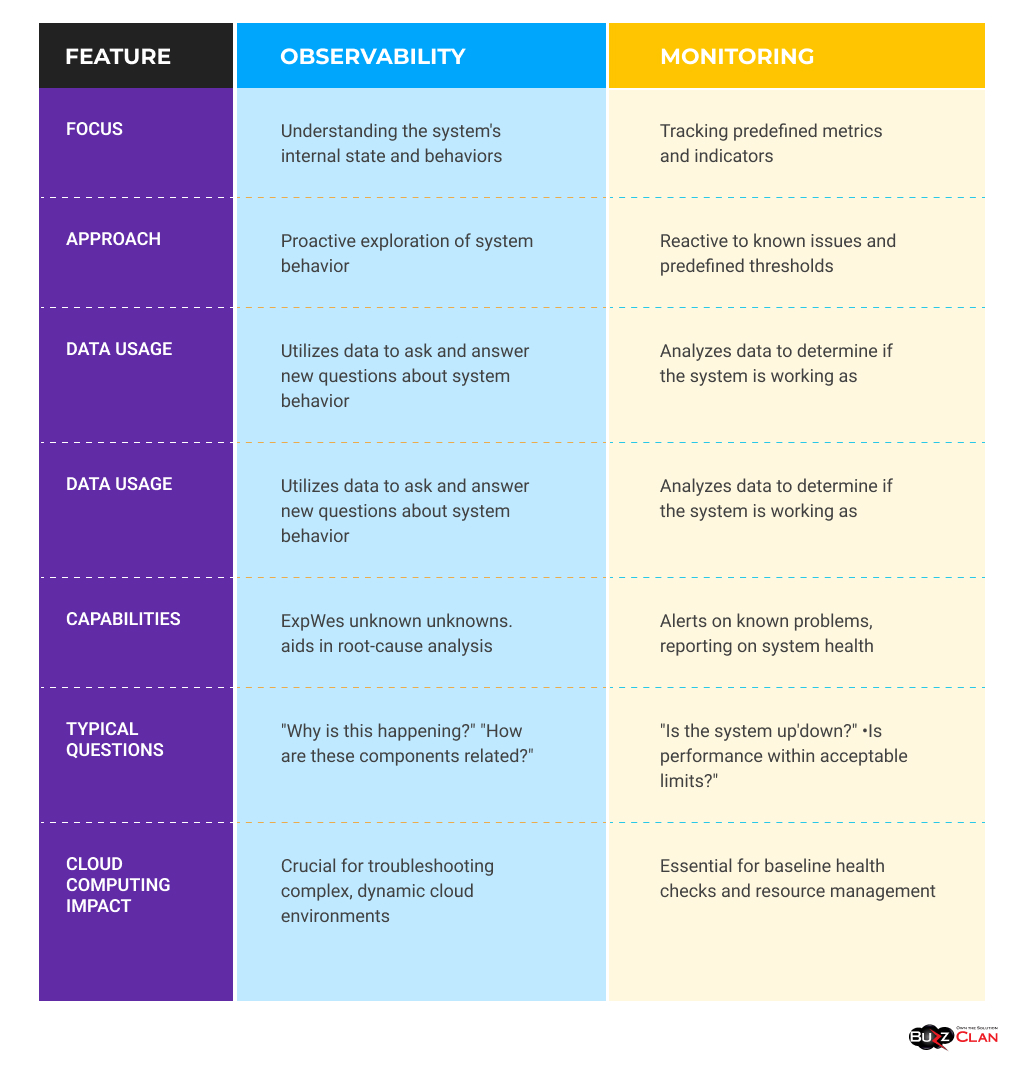
In cloud computing and IT operations, the terms 'observability' and 'monitoring' are often mentioned in tandem, yet they represent distinct concepts with unique implications. While both are integral to understanding and managing systems effectively, understanding their differences is key to implementing the right system reliability and performance strategies.
Defining Monitoring
- Basics of Monitoring: Monitoring refers to collecting, analyzing, and displaying data about a system's operation. It involves tracking predefined metrics and logs to gauge the system's health and performance.
- Purpose and Focus: The primary focus of monitoring is on the known issues – it answers the question, "Is the system working as expected?" It is fundamentally about alerting and reporting on the system’s current state.
Understanding Observability
- Essence of Observability: Observability, on the other hand, extends beyond monitoring. It is about gaining insights into the inner workings of a system based on the output data – its metrics, logs, and traces.
- Depth and Breadth: Observability allows you to ask questions you hadn’t thought of before. It is not just about whether the system is working, but how it is working and why it behaves a certain way. This includes understanding the unknown issues that might arise.
Key Differences Between Observability and Monitoring
- Proactive vs. Reactive: Monitoring is often reactive, focusing on addressing issues after they occur. Observability is more proactive, aiming to prevent issues before they impact the system.
- Data Utilization: While monitoring uses data to track known issues, observability uses data to explore and explain the unknowns within the system.
- Scope and Capability: Monitoring is a subset of observability. While you can monitor without observability, true observability includes comprehensive monitoring as part of its strategy.
Integrating Observability and Monitoring
- Complementary Strategies: Observability and monitoring are complementary. Effective system management utilizes monitoring for regular checks and observability for deeper insights.
- Tool Integration: Many tools offer monitoring and observability capabilities, allowing teams to seamlessly transition between tracking known issues and exploring unknown aspects of their systems.
The Impact on Cloud Computing
- Enhanced Cloud Management: In cloud computing, where systems are often complex and dynamic, observability and monitoring are crucial. It allows for more effective management of cloud resources, leading to better performance and reliability.
- Future Trends: As cloud environments evolve, observability and monitoring will become increasingly important. Companies that effectively leverage both will be better positioned to manage their cloud infrastructures proactively and efficiently.
While monitoring provides a snapshot of a system's health, observability offers a comprehensive view of the system’s performance and behavior. Understanding and leveraging both concepts is vital for modern IT operations, especially in complex cloud environments. As technology advances, the interplay between observability and monitoring will be key to maintaining robust and reliable IT systems.
Tools and Platforms for Enhanced Cloud Observability
In cloud observability, the right tools and platforms are essential for gaining deep insights into cloud operations. This section will cover some of the leading tools in the market, focusing on their features, functionalities, and how they enhance cloud observability.
This table concisely compares the Splunk Observability Cloud and Google Cloud Observability, highlighting their respective overviews, key features, and functionalities.
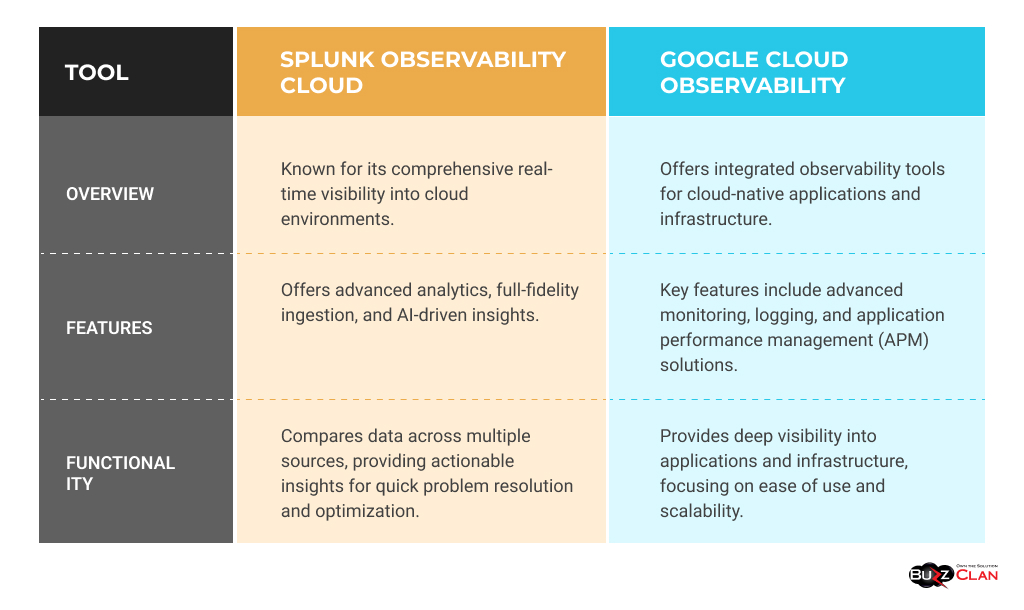
Additional Observability Tools
In addition to the major players like Splunk and Google Cloud, the observability landscape is rich with various tools, each offering unique features and capabilities. This section aims to spotlight other significant observability platforms and provide a comparative analysis to guide readers in selecting the best tool for their needs.
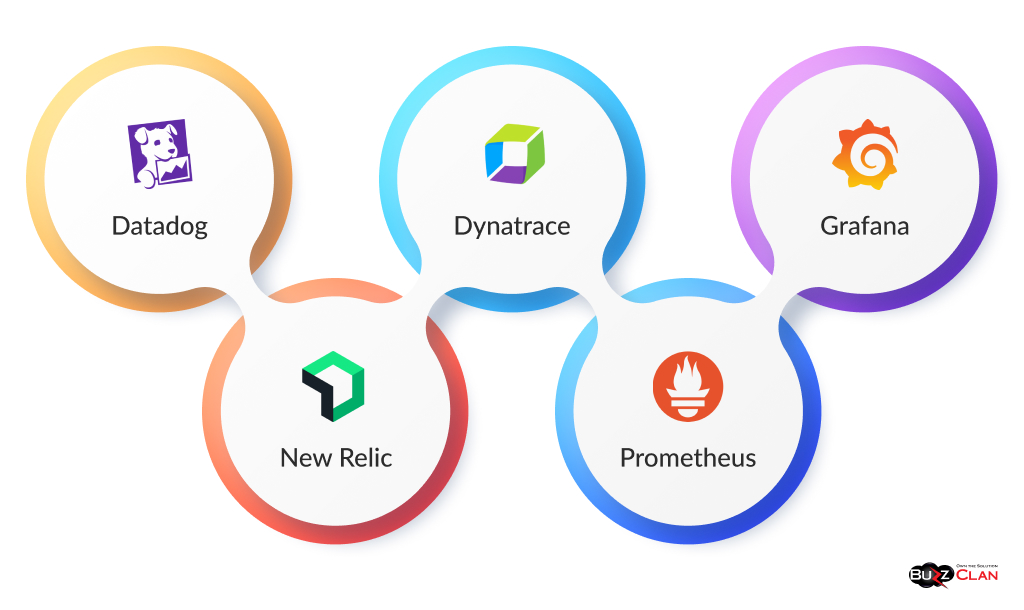
Prominent Observability Tools
- Datadog: Known for its user-friendly interface and extensive integration options. Datadog offers real-time monitoring and analytics, making it ideal for dynamic cloud environments.
- New Relic: Offers deep application performance insights and is highly favored for its detailed transaction tracing capabilities.
- Dynatrace: Stands out for its AI-powered analytics, providing automated problem detection and root cause analysis.
- Prometheus: An open-source tool that excels in monitoring and alerting, particularly in Kubernetes environments.
- Grafana: Renowned for its advanced visualization features, Grafana works well with tools like Prometheus for a comprehensive observability solution.
Comparative Analysis
- Ease of Use: Tools like Datadog and Grafana are often praised for their intuitive interfaces, which can be a deciding factor for teams with limited technical resources.
- Integration Capabilities: Consider how well each tool integrates with existing systems. Dynatrace and Datadog, for instance, offer extensive integrations, simplifying the observability across diverse environments.
- Specialization: Some tools have specialized strengths. New Relic, for instance, is highly effective for application performance management, while Prometheus excels in container monitoring.
- Cost and Scalability: Evaluate the cost-effectiveness of each tool, especially for scaling. Open-source tools like Prometheus and Grafana can be more budget-friendly but may require more setup and maintenance.
- Support and Community: The support and community engagement level can be crucial. Tools with a strong community, like Grafana and Prometheus, offer extensive resources for troubleshooting and customization.
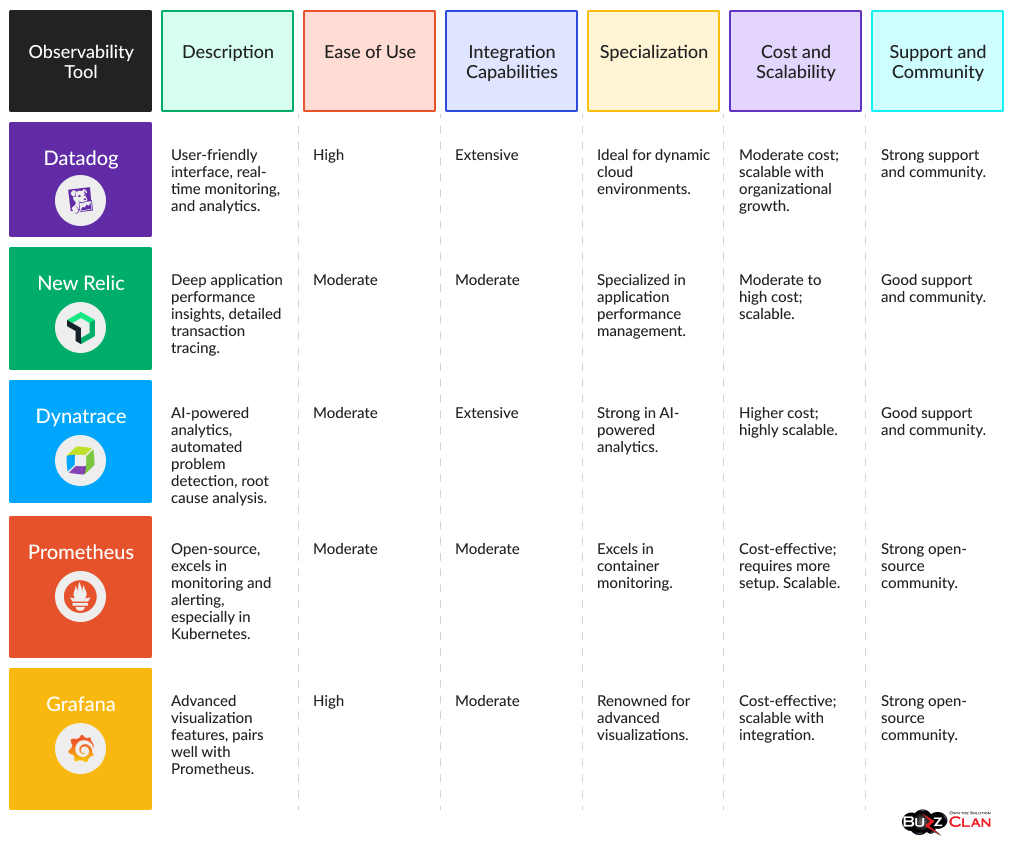
This table comprehensively compares prominent observability tools, highlighting their key features, ease of use, integration capabilities, specialization, cost and scalability, and the level of support and community engagement. This information can guide readers in selecting the most suitable tool for their specific observability needs.
Hybrid Cloud Observability
Hybrid cloud environments, which combine on-premises infrastructure with cloud services, present unique challenges in terms of observability. This section will explore these challenges and discuss the tools and strategies that can be used to achieve effective observability in such environments.
Challenges in Hybrid Cloud Setups
- Complexity and Diversity: Hybrid clouds merge different architectures, increasing complexity in monitoring and managing performance across these diverse environments.
- Visibility Gaps: Ensuring complete visibility across cloud and on-premises components can be challenging, often leading to blind spots in observability.
- Data Integration: Integrating data from multiple sources for a unified view of the system's health is another common challenge in hybrid setups.
Tools for Hybrid Cloud Observability
- SolarWinds Hybrid Cloud Observability: A comprehensive suite of tools designed for monitoring, managing, and securing hybrid cloud environments. Features include advanced analytics, integrated monitoring, and automated incident responses.
- Other Tools Overview: Overview of additional tools effective in hybrid cloud environments, focusing on their capability to bridge the gap between cloud and on-premises systems.
Strategies for Effective Observability in Hybrid Clouds
- Unified Monitoring Approach: Implementing a unified monitoring approach encompassing cloud and on-premises infrastructures to ensure comprehensive observability.
- Customized Analytics: Leveraging analytics tools that can be customized to the unique needs of hybrid environments.
- Automated Response Mechanisms: Utilizing automated response mechanisms for efficient problem resolution across hybrid infrastructures.
Hybrid cloud observability requires a strategic blend of tools and practices tailored to its unique environment. This section will provide insights into navigating the complexities of hybrid clouds, ensuring that businesses can maintain full observability for optimal performance and efficiency.
Observability with OpenTelemetry
OpenTelemetry has emerged as a pivotal framework in cloud-native observability, enabling businesses to capture and analyze a wealth of data across their cloud environments. This section will delve into the nuances of OpenTelemetry and how it enhances observability in cloud-native architectures.
Introduction to OpenTelemetry Framework
- Overview: OpenTelemetry provides a set of APIs and tools for collecting and exporting telemetry data (metrics, logs, and traces) in a vendor-neutral way.
- Capabilities: It is designed to be compatible with various platforms and languages, making it a versatile choice for diverse cloud-native applications.
- Benefits: The framework simplifies the collection and analysis of telemetry data, aiding in better monitoring, troubleshooting, and understanding cloud applications.
Implementing Observability with OpenTelemetry in Cloud Environments
- Strategic Planning: Before integrating OpenTelemetry, it’s crucial to have a strategic plan outlining which parts of your application will be monitored and what kind of data you intend to collect.
- Deployment Models: Whether deploying in a public, private, or hybrid cloud environment, OpenTelemetry can be integrated seamlessly. It’s important to understand the specifics of each environment to tailor the implementation accordingly.
- Instrumentation of Applications: This involves adding OpenTelemetry SDKs to your cloud-native applications. It’s essential to ensure that the instrumentation is thorough to capture all relevant data, whether for tracing, metrics, or logs.
- Adaptability: Cloud-native applications often run in dynamic environments like Kubernetes. OpenTelemetry should be configured to adapt to these changes, such as automatically scaling resources.
Data Collection and Analysis
- Data Collection Methods: Utilize OpenTelemetry’s APIs to collect various types of telemetry data. Ensure your collection methods are comprehensive, capturing everything from system metrics to user-specific traces.
- Data Correlation: Correlate data from different sources for a holistic view of the application's performance. This correlation is key to understanding complex interactions within your applications.
- Analysis Tools: Leverage OpenTelemetry’s integration with analysis tools to interpret the collected data. This can involve using observability platforms to ingest OpenTelemetry data for advanced analytics.
Best Practices for Implementing OpenTelemetry
- Continuous Monitoring: Set up OpenTelemetry for continuous monitoring, allowing for real-time insights into application performance and quick anomaly detection.
- Customizing Data Collection: While OpenTelemetry provides default instrumentation, it’s often beneficial to customize data collection to focus on the most critical aspects of your application.
- Performance Overheads: Be mindful of the performance overhead that instrumentation can introduce. Optimize the configuration to balance the detail of observability and application performance.
- Security Considerations: Ensure that the telemetry data collection and transmission are secure, especially when dealing with sensitive data.
- Regular Updates: Keep the OpenTelemetry components updated to take advantage of new features and improvements in the framework.
By carefully integrating OpenTelemetry into cloud-native applications, organizations can achieve a comprehensive observability setup that provides deep insights into application performance and user experience. This holistic approach to observability is essential for maintaining robust, efficient, and scalable cloud applications.
- Resources and Learning: For professionals and organizations keen on implementing OpenTelemetry, a wealth of resources and learning materials are available. This section will provide an overview of these resources and case studies that illustrate the practical benefits and impact of OpenTelemetry in real-world scenarios.
Guides and Documentation
- Official OpenTelemetry Documentation: The OpenTelemetry website hosts comprehensive documentation, offering a deep dive into its APIs, SDKs, and tooling. It’s a vital resource for understanding the fundamentals and advanced aspects of OpenTelemetry.
- Online Tutorials and Courses: Various platforms like Coursera, Udemy, and Pluralsight offer tutorials and courses ranging from beginner to advanced levels, helping individuals understand how to implement and use OpenTelemetry effectively.
- Blogs and Community Forums: Blogs written by observability experts and community forums such as Stack Overflow and Reddit provide valuable insights, tips, and troubleshooting advice. These platforms facilitate community support and knowledge sharing.
- GitHub Repositories: GitHub hosts numerous repositories with code examples, integrations, and custom configurations that can be particularly useful for developers looking to customize OpenTelemetry for their specific needs.
OpenTelemetry stands at the forefront of observability solutions, particularly in cloud-native environments. This section will guide readers through its framework, offering insights into how it can be effectively leveraged to gain a comprehensive understanding of cloud application performance and health.
Integrating Observability into Cloud Security
Integrating observability into cloud security is critical to maintaining robust and resilient cloud operations. This section will explore the intersection of these two domains and discuss various approaches to ensure secure and observable cloud environments.
The Intersection of Security and Observability
- Conceptual Overlap: Understanding how observability and security complement each other in cloud environments. While observability focuses on system performance and health, it provides valuable insights to enhance security postures.
- Proactive Security Stance: Exploring how observability tools can help identify security anomalies and vulnerabilities, thus enabling a more proactive approach to cloud security.
Approaches to Ensure Secure and Observable Cloud Operations
- Integrated Solutions: Tools and platforms that combine observability and security features, offering a unified approach to managing cloud operations.
- Real-time Monitoring and Alerts: Leveraging observability for real-time security monitoring, ensuring immediate detection and response to potential threats.
- Data Analysis and Forensics: Utilizing observability data for security analysis and forensic investigations, aiding in understanding the root causes of security incidents.
Best Practices for Cloud Security Observability
- Comprehensive Logging: Implementing comprehensive logging strategies that cover security-related events, enabling detailed analysis and auditing.
- Collaboration Between Teams: Encouraging collaboration between security and operations teams to leverage observability insights for enhanced security measures.
- Continuous Evaluation: Regular evaluation of observability and security tools to keep pace with evolving cloud technologies and threat landscapes.
Integrating observability into cloud security is not just about adding more tools but creating a cohesive strategy that leverages both strengths. This approach enhances the ability to detect and respond to security issues and contributes to cloud operations' overall health and efficiency.
Cloud Observability Best Practices
Implementing cloud observability effectively is crucial for obtaining the full spectrum of benefits it offers. This section focuses on best practices for implementing, maintaining, and scaling observability solutions in cloud environments.
Key Strategies for Effective Implementation
- Comprehensive Coverage: Ensure that your observability strategy covers all aspects of your cloud environment, including applications, infrastructure, and network.
- Tool Integration: Select and integrate observability tools that provide a unified view of your systems and allow easy data correlation across different sources.
- Automated and Contextual Alerts: Set up automated alerts that notify teams of issues and provide contextual information for quicker troubleshooting.
Maintaining Observability Solutions
- Regular Audits and Updates: Regularly audit your observability tools and processes to ensure they align with your evolving cloud environment.
- Data Management: Efficiently manage the data generated by observability tools, ensuring it is actionable and not overwhelming.
- Feedback Loop: Establish a feedback loop where insights from observability data are used continuously to improve processes and systems.
Scaling Observability Solutions
- Scalable Architecture: Implement an observability architecture that can scale with your cloud environment, accommodating growth and changes in demand.
- Performance Optimization: Regularly review and optimize the performance of observability tools to handle increased loads without affecting system performance.
- Training and Knowledge Sharing: Invest in training for your teams to keep them up-to-date with the latest observability practices and tools.
By adhering to these best practices, organizations can ensure their cloud observability strategies are robust, efficient, and capable of supporting their operational goals. Effective observability not only aids in problem resolution but also contributes to proactive system management and optimization.
Case Studies in Cloud Observability
Exploring real-world examples is an excellent way to understand cloud observability's practical applications and benefits. This section will delve into several case studies highlighting successful implementations of cloud observability, drawing out the key lessons learned and insights gained from these experiences.
Case Study 1: Large-scale E-commerce Platform
Background: A leading global e-commerce platform with a diverse product range faced challenges managing its complex cloud infrastructure. The platform experienced frequent downtime and slow issue resolution, impacting customer satisfaction and sales.
Implementation: The e-commerce company implemented a comprehensive cloud observability solution, integrating tools for real-time monitoring, automated alerting, and advanced analytics. Key observability tools were seamlessly integrated with existing systems, providing a unified view of the entire infrastructure.
Outcomes: The implementation of cloud observability solutions led to significant improvements:
- Improved Uptime: Enhanced monitoring and proactive issue detection reduced system downtime by 40%.
- Faster Issue Resolution: Automated alerts and detailed insights enabled quicker troubleshooting, reducing issue resolution time by 30%.
- Enhanced Customer Experience: The platform's performance stability improved, leading to higher customer satisfaction and increased repeat customers.
Case Study 2: Financial Services Industry
Background: A multinational financial services corporation struggled with maintaining the security and performance of its cloud-based applications, which are crucial for handling sensitive customer data and transactions.
Implementation: The company adopted a robust observability strategy, incorporating end-to-end encryption, advanced security monitoring tools, and compliance tracking features. Observability tools were selected for their ability to provide deep insights while ensuring adherence to financial regulations.
Outcomes: Observability significantly enhanced the company's cloud operations:
- Improved Security Posture: Continuous monitoring and anomaly detection reduced security incidents by 50%.
- Regulatory Compliance: Automated compliance reports and real-time tracking ensured adherence to financial industry standards.
- Operational Efficiency: Streamlined monitoring processes improved overall system performance and staff productivity.
Case Study 3: Healthcare Sector
Background: A healthcare provider managing sensitive patient data and requiring high system reliability aimed to implement cloud observability to ensure compliance and data security.
Implementation: The provider established an observability framework aligned with healthcare regulations, including HIPAA. The solution focused on patient data security, system uptime, and efficient data management.
Outcomes: The observability framework led to substantial improvements in healthcare service delivery:
- Enhanced Data Security: Stronger data encryption and access controls significantly reduced data breaches.
- System Reliability: High system uptime ensures consistent access to patient records and healthcare services.
- Improved Patient Care: Efficient data management and system reliability resulted in better patient care and service delivery.
Each case study will provide valuable lessons and takeaways, illustrating the diverse applications of cloud observability across different industries. By examining these real-world scenarios, readers can understand how to implement and leverage cloud observability in their organizations effectively. These examples will also showcase the transformative potential of observability in enhancing cloud operations and achieving business objectives.
Future Trends in Cloud Observability
Predictions for the Evolution of Cloud Observability
- Increased AI and Machine Learning Integration: Anticipating greater incorporation of AI and ML algorithms for predictive analytics and automated problem resolution in observability platforms.
- Enhanced Real-Time Data Processing: The trend towards real-time data processing and analysis for quicker response to system changes and issues.
- Shift Towards Proactive Observability: Moving from reactive to proactive observability strategies, identifying and addressing potential issues before they impact the system.
Emerging Technologies in Cloud Observability
- Serverless and Edge Computing: Discussion on how the rise of serverless and edge computing architectures will influence observability strategies and tools.
- Blockchain for Enhanced Security: Exploring the potential role of blockchain technology in enhancing the security aspects of cloud observability.
- IoT and Observability: The proliferation of IoT devices will add new dimensions to cloud observability, requiring more sophisticated monitoring mechanisms.
New Methodologies in Cloud Management
- Observability as Code: The growing trend of 'observability as code,' where observability configurations and setups are defined and managed through code, enabling more consistent and scalable practices.
- Community: Driven Tools and Practices: The rise of open-source, community-driven tools and practices in observability, encouraging collaboration and shared learning.
- Sustainability in Observability: An increasing focus on sustainability, looking at how observability practices can be aligned with environmentally friendly operations.
These predictions and emerging trends indicate a dynamic future for cloud observability that will likely see it become more integral, intelligent, and innovative. This section will highlight what’s on the horizon for cloud observability and guide how organizations can prepare and adapt to these upcoming changes.
Further Reading
Observability in Cloud Service Management Platforms
Observability has become a key component in cloud service management platforms, critical in ensuring efficient and effective cloud operations. This section will focus on how observability is integrated into these platforms, emphasizing ServiceNow's cloud observability approach.
Role of Observability in Cloud Service Management
- Holistic System Insight: Observability in cloud service management platforms provides comprehensive insights into cloud operations, enabling IT teams to monitor and manage cloud resources effectively.
- Proactive Issue Resolution: With observability, these platforms can proactively identify and address potential issues before they escalate, improving system uptime and reliability.
- Optimized Resource Utilization: Observability tools help optimize cloud resource usage, ensuring efficient performance and cost management.
Review of ServiceNow for Cloud Observability
- ServiceNow’s Observability Features: Exploration of the observability features in ServiceNow, such as real-time monitoring, analytics, and incident management capabilities.
Integration and - Automation: Discuss how ServiceNow integrates observability with other cloud management functions and leverages automation for enhanced operational efficiency.
- User Experience and Customization: Insights into the user experience provided by ServiceNow’s observability tools, including customization options and user interface.
Comparative Analysis with Other Platforms
- Comparison with Competitors: Brief comparison of ServiceNow with other leading cloud service management platforms regarding observability features and capabilities.
- Choosing the Right Platform: Guidance on selecting the right cloud service management platform based on specific observability needs and organizational requirements.
Observability in cloud service management platforms like ServiceNow significantly advances how businesses monitor and manage their cloud environments. This section aims to clearly understand the value added by observability in these platforms and how companies can leverage these features for optimal cloud performance and management.
Conclusion: The Continuous Evolution of Cloud Observability
As we conclude our comprehensive exploration of cloud observability, it's clear that this field is not just a passing trend but a fundamental aspect of modern cloud computing. Observability has proven essential in the efficient management, security, and optimization of cloud environments.
Summarizing the Importance of Observability in Cloud Environments
- Observability provides critical insights that enable businesses to maintain high-performing, reliable, and secure cloud systems. Its role in identifying and resolving issues, optimizing resources, and ensuring a seamless user experience cannot be overstated.
- Integrating observability into various cloud platforms, from large-scale e-commerce to critical healthcare services, illustrates its versatility and necessity across different industries.
The Future of Cloud Observability
- The future holds promising advancements in cloud observability. With emerging technologies such as AI and machine learning, observability will likely become more predictive and proactive, enhancing its capability to pre-empt issues and optimize cloud operations.
- The evolution of cloud computing, including the rise of serverless architectures and edge computing, will also shape observability tools' future requirements and capabilities.
Encouraging Proactive Adaptation to Future Changes
- Businesses must remain agile and proactive in adapting their observability strategies to keep pace with the rapid advancements in cloud technologies and the evolving landscape of cyber threats.
- Investing in continuous learning, staying abreast of the latest trends, and choosing scalable and flexible observability tools will be key to navigating future challenges and opportunities in cloud computing.
In conclusion, cloud observability is an ever-evolving field crucial in the modern cloud ecosystem. Its importance in ensuring the resilience, efficiency, and security of cloud environments makes it an indispensable tool for organizations looking to harness the full power of cloud computing. As we look forward to the future, staying informed and adaptable in the face of continuous change will be essential for leveraging the full potential of cloud observability.
FAQs

Get In Touch
